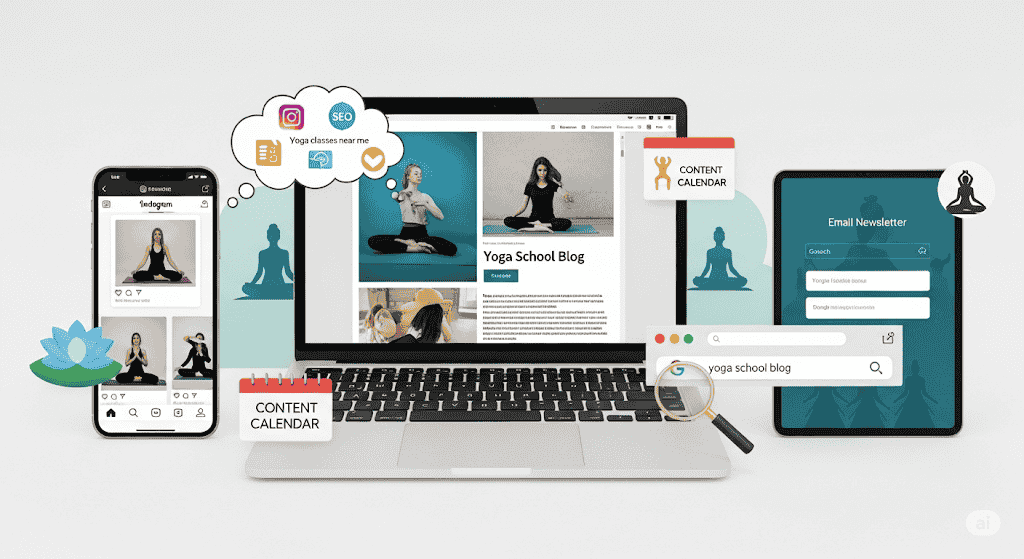The yoga industry has grown exponentially in recent years. From small local studios to world-renowned retreat centers, yoga schools are now attracting students from all over the globe. But with more yoga schools entering the market, competition is getting intense. If you’re a yoga school owner, relying on just word-of-mouth or location visibility is no longer enough.
In the digital age, your potential students are searching for you online. They’re scrolling through Instagram looking for inspiration, watching YouTube videos about yoga teacher training, and reading blog posts about retreats. This means digital marketing is no longer optional — it’s essential for the growth of your yoga school.
In this guide, we’ll explore proven digital marketing strategies that can help yoga schools, especially those offering specialized programs like Yoga Teacher training, to grow their online presence and attract more students.
In this blog, we will take an example of a teacher training program to better understand how to implement the strategies.

1. Optimize Your Website for SEO
Search Engine Optimization (SEO) is the most important part to increase your online visibility. A well-designed website with best ui/ux is also useless if it doesn’t appear when potential students search for yoga courses.
Steps to improve SEO for your yoga school:
- Keyword Research: Identify keywords that your yoga students are searching for. This includes broad terms like “yoga teacher training” and specific long-tail keywords like 200 hour yoga teacher training in Bali.
- On-Page Optimization: Use these keywords in your page titles, headings, meta descriptions, and body content. Don’t overstuff — keep it natural.
- Blog Content: Publish blog articles answering common questions, such as “What is a 200 hour yoga teacher training?” or “How to prepare for yoga teacher training in Bali.”
- Local SEO: If you have a physical location, make sure you’re listed on Google Business Profile with accurate contact details and photos.
SEO takes time, but once your site starts ranking, you’ll consistently attract targeted visitors without paying for ads.
2. Create an Instagram-First Social Media Strategy
Yoga is inherently visual. From serene beaches in Bali to deep meditative postures, your school’s story can be told beautifully through images and short videos.
Tips for using Instagram effectively:
- Post a mix of inspirational content, student testimonials, and behind-the-scenes moments.
- Use Instagram Reels to share quick yoga tips, sunrise meditations, or snippets from your training sessions.
- Add relevant hashtags like #YogaInBali, #YogaLife, and #YogaTeacherTraining.
- Always try to be connected with your audience — reply to their comments, answer DMs, and comment on posts from your followers.
If you have a 200 hour yoga teacher training in Bali program, showcase it visually. Post reels of the training, interviews with teachers, and clips of the natural surroundings to create a sense of longing in potential students.
3. Leverage YouTube for Educational Marketing
YouTube is the second-largest search engine in the world, and yoga students use it extensively for tutorials and research. By creating videos, you can position your school as an authority and connect with viewers on a personal level.
YouTube content ideas for yoga schools:
- A day in the life of a student at your training program.
- Tutorials on specific poses or sequences.
- Q&A videos about your 200 hour yoga teacher training in Bali.
- Virtual tours of your training facilities and accommodation.
The best part? YouTube videos can also rank on Google, bringing in even more traffic.
4. Use Facebook & Google Ads for Faster Results
While SEO and organic content take time, paid ads can give you instant visibility.
Facebook & Instagram Ads:
- Target people interested in yoga, wellness, and meditation.
- Use location targeting for cities or countries where yoga students are most likely to travel from.
- Retarget visitors who’ve been to your website but haven’t signed up yet.
Google Ads:
- Bid on keywords like “yoga teacher training Bali” or “best yoga school in Bali”.
- Direct ads to a high-converting landing page with detailed course information and testimonials.
Pro Tip: Test different ad creatives and headlines to see what works best for your audience.
5. Build a Strong Email Marketing Funnel
Email marketing is one of the most effective tools for converting interested visitors into paying students.
How to use email marketing for yoga schools:
- Lead Magnet: Offer a free guide, like “10 Things to Know Before Joining a Yoga Teacher Training in Bali,” in exchange for their email.
- Automated Follow-Up: Send a series of emails introducing your school, sharing success stories, and answering FAQs about your 200 hour yoga teacher training in Bali .
- Exclusive Offers: Give early-bird discounts or bonus classes for those who sign up quickly.
With the right email sequence, you can keep your school top-of-mind for weeks or even months until a student is ready to book.
6. Showcase Student Testimonials & Success Stories

Social proof is a powerful trust-building tool. When prospective students see real people who have benefited from your training, they’re more likely to take action.
Ways to use testimonials:
- Create a dedicated “Success Stories” page on your website.
- Post video interviews of graduates sharing their transformation journey.
- Share before-and-after skill progress — for example, how a beginner became a confident teacher after your program.
Feature stories specifically from those who attended your 200 hour yoga teacher training in Bali so readers can relate directly to that experience.
7. Collaborate with Influencers and Bloggers
Partnerships with influencers and wellness bloggers can greatly expand your reach.
Collaboration ideas:
- Invite influencers to join a part of your training in exchange for promotion.
- Have wellness bloggers review your program and link back to your site.
- Offer affiliate commissions for every student they refer.
These collaborations not only drive traffic but also create high-quality backlinks that help with SEO.
8. Host Webinars & Virtual Classes
Webinars are a great way to engage potential students before they commit to traveling.
Examples:
- “Introduction to Yoga Teacher Training: What to Expect”
- “Preparing for a 200 Hour Yoga Teacher Training in Bali”
- “How to Turn Your Passion for Yoga into a Career”
At the end of the session, invite participants to learn more about your in-person program.
9. Use Content Marketing to Educate & Inspire
Blogging isn’t dead — in fact, it’s one of the best ways to drive consistent traffic to your site.
Content ideas:
- “Benefits of Yoga Teacher Training in Bali”
- “How to Choose the Right Yoga School for You”
- “The Complete Guide to 200 Hour Yoga Teacher Training”
Make sure to naturally include your keyword 200 hour yoga teacher training in Bali in relevant posts, linking back to your main course page.
Final Thoughts
Growing a yoga school in today’s competitive market requires more than just offering great classes — it requires a strategic digital marketing plan. By focusing on SEO, social media storytelling, paid advertising, email marketing, and collaborations, you can reach students from around the world.
If your school offers programs like 200 hour yoga teacher training in Bali, your marketing should highlight not only the course content but also the unique location, culture, and lifestyle that students will experience.
The more value and trust you provide online, the more likely potential students are to pack their bags, book a ticket, and join you on their yoga journey.







Leave a Reply